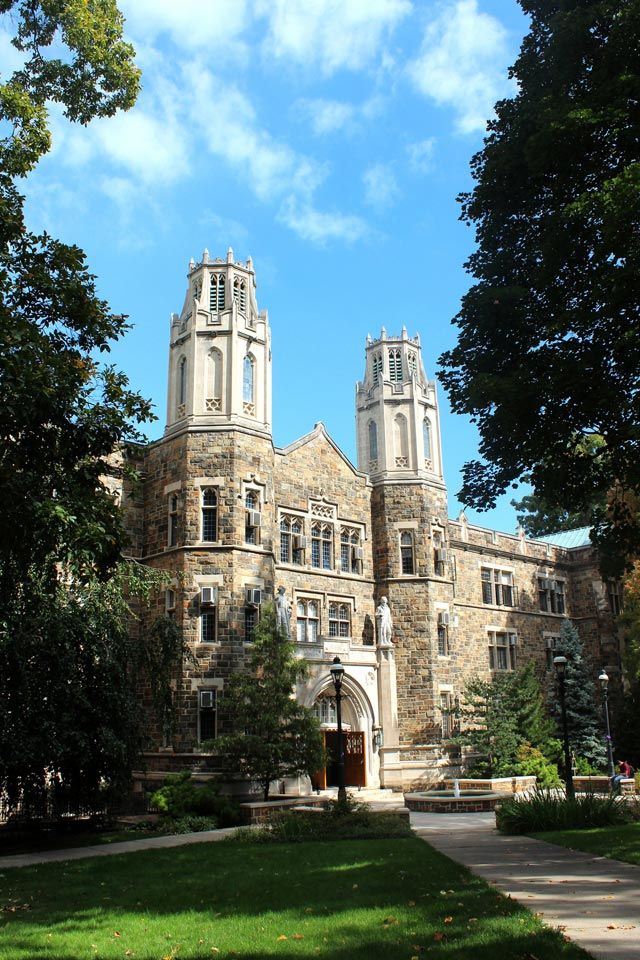The intensive, 10-month M.Eng. program in structural engineering prepares graduates for professional practice.
It’s one thing to run a computer simulation to predict the failure load for a beam, column or other structural component.
It’s quite another to apply more than 100,000 pounds of force to a reinforced concrete beam and watch it slowly crack and then, with one loud bang, collapse into a pile of rubble.
Students working toward a master’s of engineering in structural engineering at Lehigh get to do both. The intensive, 10-month master’s of engineering (M.Eng.) program starts in the summer with the Structural Behavior Laboratory, where students conduct destructive tests to determine how structures behave.
These experiments lay the groundwork for the program’s centerpiece, the group design project, in which students work in small groups to design a major structure. They use the actual architectural drawings of a structure that has already been built, but they start from scratch, reviewing structural codes, investigating and choosing structural systems, and presenting their final designs.
“The most beneficial part of the program was the design project. We learned how different structural systems work together and we learned the importance of communication.” —Janelle Heminitz
Students compare building systems, such as steel staggered truss, composite steel beams, precast concrete and post-tensioned concrete two-way flat plate. They also learn about the many complexities that go into building a structure. For example, when engineers build a parking garage out of structural steel, they must add protective coatings to the steel because salt and other residue brought in by cars can cause the metal to corrode.
In the group design project, which runs the course of the M.Eng. program, the students periodically present their designs to professors and engineering professionals, including some who work for the very firm that built the original structure. During these presentations, they field questions from experienced engineers and defend their findings.
“I believe the most beneficial part of the program was the design project,” says Janelle Heminitz, an alumna of the program who now works for Alfred Benesch & Company in Allentown, Pa.
“The project was much more in-depth than any assignment I had as an undergraduate. We learned how different structural systems work together, and we used the same references we would be using later in our professional careers, such as various codes and computer software for analysis.
“We also learned the importance of communication, not only between group members, but also with outside parties.”
In fact, every aspect of the M.Eng. program, which enrolled its first class in 2008 and now has 26 students, is designed to prepare students for successful careers as practicing engineers. The program emphasizes practical knowledge and design experience over theoretical research.
“I chose the M.Eng. program rather than the M.S. program because I wanted a design-based program,” says Christopher Buente, a graduate of the program’s first class who now works for Wiss, Janney, Elstner Associates, Inc. in New Jersey.
“The M.Eng. program is also condensed into one year. I was anxious to get out into the workforce so the one-year degree was perfect.”
The program is directed by Jennifer Gross, a professor of practice with 12 years of industry experience. As a professional engineer, Gross has worked on such projects as the convention center and hotel complex at Gaylord National Harbor in Oxon Hill, Md.; The Borgata Hotel Casino and Spa in Atlantic City, N.J.; and Seuss Landing at Universal Studios, Islands of Adventure in Orlando, Fla.
“Becoming a professor seemed like an exciting way to work with students and teach them what I know,” Gross says. “This program is geared toward the practical applications of engineering. Everything the students are learning about, I have done.”
Students in the program use the world-renowned structural testing facilities in Lehigh’s Fritz Engineering Laboratory and ATLSS (Advanced Technology for Large Structural Systems) Center. They also have a dedicated computer lab equipped with the same software that practicing engineers use.
An executive advisory board composed of representatives from leading engineering firms and partners makes sure that the curriculum meets industry needs. Advisory board members also interact with students, critiquing the group design project, giving guest presentations and supporting scholarships.
“We help advise the M.Eng. program because it gives us the opportunity to provide input as to what a practicing engineering company looks for in a graduating student,” says Daniel A. Cuoco, P.E., presi- dent and chief executive officer of Thornton Tomasetti.
Thornton Tomasetti and other advisory board companies host students for externships during breaks between semesters. Students shadow engineers, assist on projects and make professional connections.
“I had a wonderful experience at Wiss, Janney, Elstner Associates, Inc., which specializes in forensic engineering,” says Michelle Tillotson, who will graduate from the program in May. “I was able to visit the site of a garage collapse. My experience showed me the benefits of getting my master’s degree and reaffirmed my passion for structural engineering.”
The most prestigious engineering firms generally consider a master’s degree to be the entry-level degree for practicing structural engineers. Lehigh’s M.Eng. program gives students the experience and knowledge they need in a short period of time so they are prepared to enter the workforce quickly.
Even in a tight economy that has hit the construction industry especially hard, most of the program’s graduates have found jobs. They have gone into bridge or building design, forensic engineering and construction management. One alumnus works in the aerospace industry, and another does structural analysis for submarines.
The class of 2011 looks forward to the same success.
“This program has allowed me to conduct the full structural design of a complicated project using the tools and techniques actually employed in industry,” says Dale Statler, who will complete the program in May.
“I believe that my exposure to advanced course work in structural analysis and design, combined with the practical design experience, will make me a much more competitive job applicant and a far more capable structural engineer.”

